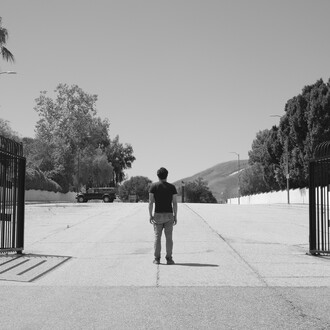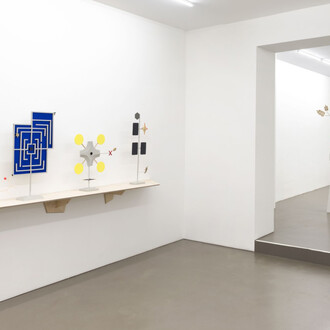Cyprien Gaillard’s new stereoscopic film, Retinal rivalry (2024), is an entrancing journey through Germany’s urban landscape and its layers of historical and social significance. A decade after the premiere of Nightlife in 2015, Monika Sprüth and Philomene Magers are honoured to present the German debut of Gaillard’s major new film installation during Gallery Weekend Berlin. Building on his previous exploration of the sculptural qualities of three-dimensional moving images, the work extends beyond the confines of the screen. By harnessing cutting-edge technology to its full potential, Gaillard offers an expanded, sharpened and deeply affecting novel view of the world around us. The solo show shares its title with the film and is completed by new wall sculptures.
Retinal rivalry is named after the visual perception phenomenon that occurs when the brain receives two conflicting images at the same time. Instead of blending into one 3D image, the neural system alternates between prioritising one image while suppressing the other, causing confusion and discomfort for the viewer. Gaillard’s film engages with these complexities of visual processing and the limitations of technology, collating visual information through exceptional, often tongue-in-cheek, shots that intertwine the inside and outside, the contained and dispersed, and the natural and built. His camera adopts unusual viewpoints, shifting from smooth aerial perspectives to a rodent’s low gaze, darting dizzyingly in and out on the bulbous nose of a sculpture, or showing a long shot of a train moving through a landscape. These draw us into a layered experience, which teeters between a bad trip and the unexpected beauty that provides solace.
Throughout Retinal rivalry, various stairs, spirals and lifts allude to a state of constant ascent and descent, emphasising the interplay between distance and closeness, chasmic depth and vivid sculptural representation. The film rhythmically pulses with images that swell and contract, inflate and deflate. Manipulating viewers’ sense of depth, scale and texture, it renders familiar materials and locations uncanny, highlighting the inherent inaccuracies and distortions of representation. Shot at 120 frames per second and projected at the same rate—five times the standard rate in cinema—Gaillard captures more than the human eye can naturally perceive. Recording the ordinary world in magnificent detail while aiming to look beneath the surface of things, Retinal rivalry is a depiction of space and time, destabilising modes of representation and offering a new hyper-vision version of reality.
An early scene places us inside a glass recycling bin, up close between discarded bottles that stretch deep behind the screen and flies buzzing around our heads— Gaillard’s objects materialise in space. Vignettes of collectable Meissen porcelain animal figurines appear like strange scavengers among the rubbish. The bottlenecks and broken glass call to mind the composition of Caspar David Friedrich’s The sea of ice (1823–24), with its sharp step-like layers of sheets of ice. When the container opens, the “sea” of spirit and wine bottles spills into a dump far below, performing a kind of ritualistic libation in remembrance of the dead. Gaillard has made alcohol and its deteriorative and amnesic effects the subject of previous works, such as his anti-monument Recovery of discovery (2011), a pyramid made of beer bottles, which touches on the paradox of (self-)destructive behaviour driven by the instinct for (self-) preservation. Retinal rivalry evokes moments of intoxication and disorientation as we are enveloped inside the head of Bavaria, a nineteenth-century female personification of the Bavarian state, the first colossal bronze statue made since classical antiquity. A shaky shot slowly draws us towards an opening, revealing a view of the Oktoberfest’s big wheel turning above Munich. At the feet of “Mama Bavaria” lies what is known as Kotzhügel (vomit hill) on the fringe of the beer festival, where an inebriated young man sleeps off his hangover. Back inside the statue’s head, the camera moves nervously from side to side as if to ask: how did we get here?
Full of extraordinary clashes, Retinal rivalry embodies the dynamics of memory and endless cycles of both literal and figurative destruction and construction. One notable example features a drunkenly misplaced iPhone, which displays a colourful animated psychedelic wheel before tumbling through a stairwell. We land below ground, beneath the Cologne Cathedral, where the remains of a Roman city wall are integrated into a 1970s car park, a corner of which shows traces of drug use. In another striking scene, the camera scans several posters advertising an immersive Van Gogh exhibition, before aligning itself with the painter’s eye, pushing into the graffiti-covered wall and scraping along its length for a true immersive experience. A later sequence portrays the misty views of Saxon Switzerland and its iconic rock formation, the Bastei, a well- developed tourist attraction, shaped by invasive alterations over the years. Once more, Gaillard’s lens intervenes, penetrating the stone that lies behind a protective glass covering, making us forget what we are looking at. Gaillard’s techniques evoke an atmosphere of delusion—an expedition into the irrational, a realm where seeing is hallucinating and viewers navigate between heaven and abyss, between a heightened reality and the loss of a sense of reality.
The spectral images scrutinise our relationship with public space as a common good, prompting questions about our navigation of the present and the intricacies of the inheritances that surround us. A Burger King occupies a former electric substation for the Nazi rally grounds in Nuremberg; an open-mouthed mascaron on a Weimar Art Nouveau building now crowns a cash machine, creating a jarring portal that connects the digital and physical worlds. Elsewhere, a barely-there glossy cellophane wrapper shimmers, and the sticky tape plastered across an improvised Michael Jackson memorial (originally a statue of Renaissance composer Orlando di Lasso) glistens iridescently, transforming the ethereal into the palpable.
The film’s score draws from diverse sonic elements, bolstering its exploration of dissonance and synchrony. Indonesian instrumental music is reworked and combined with field recordings of heavy machinery rumbling and strangely melodic retching. The soundtrack also incorporates the opening lines to Werner Herzog’s Aguirre, the wrath of God (1972), along with its accompanying overture by German band Popol Vuh. The soundscape of Retinal rivalry contrasts its images—what we see is often at odds with what we hear. Only one section lets sound and image converge: a fractured leg pumps the pedal of an interactive organ to play a piece by Johann Sebastian Bach that repeatedly falters.
Amplifying the film’s themes of conservation and decay, Gaillard’s new wall sculptures explore the patterns by which forms, spaces and histories interweave across time. Penombra (Prelievo C) (2024), derived from the adjustable visors that shade the screens of Italian cash machines, evokes elements reminiscent of medieval armour, while embodying the reliance on cash payments in a country struggling to break away from its shadow economy. Opposite, a new series of fabric-wrapped acoustic panels, salvaged from the gutted auditorium of Trieste’s Museo Revoltella, line the gallery wall. The large-scale panels bear the beautiful ghostly pattern of repeated touch: past visitors brushed against the fabric, inadvertently leaving marks that turn the surfaces into abstract canvases or modern cave paintings. Each work features a single, hand-embroidered motif along one edge, where the material once concealed by frames transitions into exposed sections. Stitched onto this demarcation, a dancing skeleton, inspired by the Danse macabre, serves as a reminder of death’s inevitability and alludes to the echoes of past eras, spaces and sounds.
The exhibition Retinal rivalry maps social space in entirely new ways, uncovering poetic parallels, anachronisms and overlaps everywhere. The film’s keen awareness of the interconnectedness of time transforms the settings, phenomena and objects typically regarded as peripheral into mind-bending sculpted light, leaving an indelible impression that continues to reverberate long after it has been experienced.
The film Retinal rivalry will be on view at Haus der Kunst in Munich from October 3, 2025, to March 8, 2026.
The soundtrack to Retinal rivalry will be released later this year by Berlin-based record label PAN.
















